Stretching Macromedia Flash By Adding Extensions
Many animation studios, like our own, have discovered that Flash can be adapted as a significant part of their production pipeline. As a platform for creating traditional 2-D style animation, Flash has many advantages. In this article I want to talk about one of those advantages that is not very well known. It is technically refered to as Extensibility, but as you will soon learn it is really an easy way to add flexibility and customization to your artistic environment.
With the release of Flash MX 2004, Macromedia added a brand-new Extensibility layer, which lets users of Flash extend its functionality. With the Extensibility tools, a user can literally extend Flash to do things it cannot do coming straight out of the box. Things such as adding new custom commands, customizing the tool bar, adding brand new custom created tools and a lot more. Fortunately, for those of us not as technically gifted, there are many people who are creating added functionality for Flash that we can just install and use. The trick is knowing what is out there and how to get it.
One place to start your search is the Flash Exchange. This is a repository of extensions collected by Macromedia and made available to Flash users. We found a very useful extension there recently, Seibs TimelineScale. This extension is used to automate scaling the Flash timeline. For example, if you have created a sequence of animation and wanted to pad it out to a different frame rate or just to slow down the action uniformly you could go to the timeline and frame by frame insert additional hold frames in between keys. Very tedious and time consuming for all but the shortest of sequences. But with this extension you just enter the number of hold frames you want added between keys and press one button and that's it. So taking a sequence from 1's to 2's or 3's or even 4's is a snap. You also can scale the timeline for a specific range of frames which allows you to use this great tool for setting up more complex timing patterns.
There also is a section on the Macromedia web site called Third Party Extensions that showcases many commercially available products. Perhaps one of the most interesting of these is Swift 3D Xpress. Swift 3D Xpress is a 3D Extension for Macromedia Flash MX 2004 that allows users to convert drawings and text on the Flash stage into 3D animations without having to leave the Flash interface.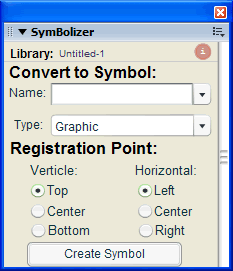
One of the great advantages of Flash extensions is their ability to really automate tedious tasks and save you time. Naming and organizing library symbols is just such a task. We use a really sweet extension called The Symbolizer to assist our production work. The Symbolizer is an extension for Flash MX 2004 that helps speed up the organization and management of symbols by helping to create structured symbol names and sorting the symbols to folders as you create them. It features a well thought out interface with a dual faced panel plus a naming memory capability. If you're sick of having to retype symbol names over and over each time you create a symbol then you will love this feature. And not only does this extension remember your naming patterns but it also provides for prefixes and suffixes as well as an auto incrementing ability creating names like prefix_name_suffix_1. You can also create folders and subfolders with ease and have your symbols automatically created in the desired folder.
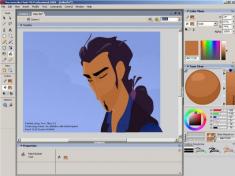
But we have just started to scratch the surface of what you can do with extensions. This next group of extensions really has made our life easier and significantly improved our production workflow. The first and totally indespensible of these extensions is Toon Titian. This is an all purpose ink and paint assistant. It will automatically generate cel-shades, blends, gradients, complements, and keeps you NTSC color safe. It additionally provides for temporary storage of color pallettes as well as permenant storage of character style colors. And as if that isn't enough it also has a great tool for rendering lines to give them that hand inked look.
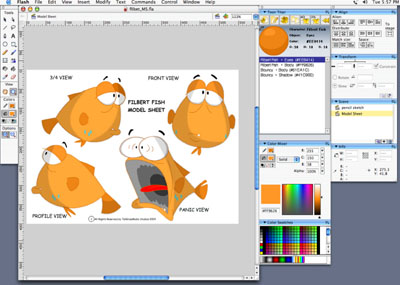
Another great extension we use is Nested Timeline. Nested Timeline allows you to scrub through the timeline of any selected symbol without actually having to open the symbol for editing. This is such a great tool for doing lip sync as well as any other animation where you need to select a specific frame from a library of replacement parts. Swaping mouths, eye brows, hands, what ever you need to replace to support your limited animation actions is made so much easier with this tool.
Ever wanted to have a more cinematic style of camera for Flash? Well take the lens cap off your Flash Camera and just use the view finder. The Flash Camera frees you from the constraints of the stage. You may now use the entire work area to produce content. Only that which is located within the cameras boundries, is published (displayed) upon export. The camera can be panned, trucked, rotated and even has zooming capabilities. Easy to use. Tween it, scale it, and rotate it just as you would any other symbol. This little gem opens up lots of possibilities for getting the right shot.
Here is another really nice extension called the Baked Sequence Command. The Bake Sequence command is a simple yet powerful command that essentially performs the opposite of the native "distribute to layers" command of Flash. Except that it works on a much larger scale by flatting down an entire sequence which may be composed of unlimited layers, into a single more manageable frame by frame sequence in Flash. For those times when you create work on many seperate layers but need to collapse it down to a single layer this is the answer.
Another favorite place to look for interesting extensions and components is 27 Bobs web site. Stop by and check this amazing place out. One of the more popular of Bob's extensions is the Perspective Grid which provides a great tool for layout using 1, 2, or 3, point perspective grids right on the Flash stage.
If you want to learn more on this important topic I recommend that you visit Patrick Mineault's great recap of the world of Extensibility for Flash. And if you want to do it yourself, try reading Extending Macromedia Flash MX 2004 by Keith Peters & Todd Yard.
Getting Back To Cartoony Cartoons Part 2
This is the second in a multi-part series on the subject of cartoons and cartoon making. My goal in these articles is to explore writing and making the short format cartoon which can range in length from 1 to 7 minutes. If you missed the first part of this series you can read it here.
One observation that I have made over the years as I watch and study a wide variety of cartoons is that there is for the most part a subtle but noticeable difference between most of what can be termed classic cartoons of the late 1930s to the mid 1950s and today's cartoons. It has to do with the way the cartoon flows. At first I thought it must be something to do with the fact that these classic cartoons were made for viewing in movie theaters while most of today’s cartoons are mostly made for TV. But after researching many of the creators of these classic cartoons and reading many of their writings about how they learned and performed their craft, I found a more basic reason for this difference. It has to do with rhythm. We all know that timing is one of the cornerstones of animation and there are plenty of books and articles that focus on timing of individual actions. But the great directors like Clampett, Avery, Jones, Freleng and McKimson also focused on a different level of timing. They actually planned out the timing of the entire cartoon.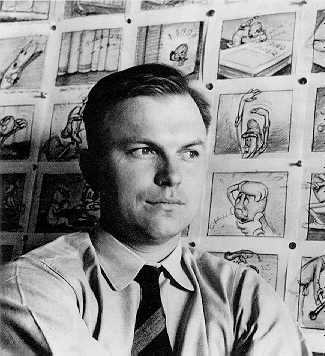
When I first read the book "Chuck Amuck" by Chuck Jones, I sort of glossed over the parts where he talked about meticulously timing cartoons before starting the layouts. I thought he was just referring to making sure the film fit exactly into its 6 minute format. I thought it was a cost control measure imposed on the directors to insure that no wasted footage was created. It seemed logical that the executives at the studios did not want to waste money on work that never would reach the screen. That view was very true, but I really missed the point on my first interpretation of what Chuck was discussing. 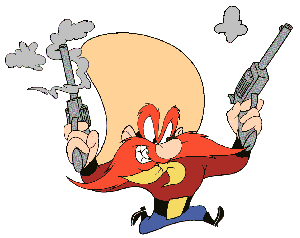
He talked about learning from Friz Freleng and others to exactly time their films on bar sheets. They used musical bar sheets. Perhaps my ignorance of music and composition caused me not to see any particular significance to this practice. The classic cartoons were timed to musical tempos. Today's cartoons are just timed straight ahead, action by action. They are random in their rhythm, and they feel jerky. The classical cartoons have rhythm. Just like in music, tempos vary, slow then fast; the rhythms weave in and out of each other and create moods. Classic cartoons flowed from this musical influence. I had a bit of a "well slap my forehead" experience as I realized this observation. It totally must have evolved from the early 1930s when sound cartoons all were basically animation set to music. (The Silly Symphonies, the Merry Melodies, the Looney Tunes etc) To make those kinds of cartoons they had to learn to time the pace and flow of the cartoons to the music. The music came first; it wasn't added after the fact. So that skill of learning to time cartoons to music stayed on as an influence even when the original reason it was done had stopped.
This is a very important observation because it points to one of the unique aspects that make animation potentially very different from live action. Music has the power to sweep its listeners up and to invoke emotions and feelings. And cartoons have this same power, if the film maker is aware of how to compose and arrange his cartoon composition.
A cartoon can be thought of as a composition much the same as a musical composition. Music to be truly expressive needs melody and rhythm. Harmony, syncopation, structure, and movements are all variations and arrangements of the melody and rhythm. Cartoons compositions substitute pictures for melody and use rhythm to regulate the flow of the pictures. Without rhythm and pacing, a cartoon does not deliver its maximum potential. Rhythm and pacing give a cartoon added punch. They help to establish a cohesive experience a more synergistic impact. In planning a cartoon a film maker wants to use tempo, contrasting actions and sequences. These are the tools of pacing. You alternate slow scenes with fast scenes, dialogue scenes with action scenes, and give each sequence its own tempo. You want to create a rhythmic wave to the cartoon. It rises and falls continuously building an over all mood straight through to a climax.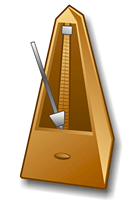
The value of this approach is that everything is focused by a firm framework that is organized and controlled by a holistic vision, a compositional flow. It isn't just a matter of taking a situation and based on the characters interactions and reactions throwing together a string of funny gags. It is a well thought out composition. Can you create cartoons without a compositional approach? Absolutely, but imagine the additional impact your cartoons would have by adding this more powerful approach.
Cartoons should be fun, Fun to make and fun to watch. They shouldn't be realistic, but rather they should be outrageously unrealistic both in their visual appearance and in their content. Things that aren't possible in real life are and should be totally possible in a cartoon. Cartoons are for entertainment and escape from the everyday world. The wilder they are the better. A well written cartoon needs familiar characters that are put into a situation, usually the more absurd the setting the more outrageous the story can be. Then the writer tries to rhythmically construct a composition of ever escalating gags, centered on the situation, climaxing with a final punctuation gag that hopefully has been completely unexpected and yet thematically flows from the prior action. The more absurd the cartoon is the better. Cartoons are supposed to be cartoony. There are no boundaries beyond the common dictates of acceptable taste. The only rule you need to follow is that it must be entertaining for the viewers including but not limited to yourself.
Genndy Tartakovsky's Dexter's Laboratory is a great example of modern cartoon writing and composition. Beginning with his characters, Genndy believes strongly in contrasts. Dee Dee's character is designed as a ballerina; she is tall and slender with long legs. She always acts in a much exaggerated way. She is always striking a pose as if she were pretending to be a ballerina. Dexter is short and squat. Dee Dee is lively and graceful while Dexter is subdued and almost mechanical.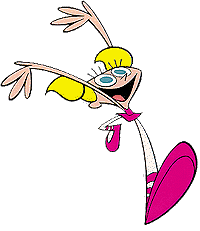
At first glance the coloring style of these cartoons is not very sophisticated. There is very little use of muted or neutral colors. But there is great energy in this style. Genndy uses lots of orange purple yellow blue and pink. This could be very distracting but Genndy sticks to only two or three colors in a scene and the background colors are composed around the action and help to guide the viewer visually. The timing in a Dexter cartoon is really amazing. Genndy not only has great timing of individual actions but the pacing and the rhythm of the entire cartoon is obviously well planned. In Dexter's Lab, Genndy uses beats and contrasted actions and sequences to create his desired audience experience. He alternates slow scenes with fast scenes, dialog scenes with action scenes and each sequence has its own tempo. In the better episodes the rhythm rises and falls building toward the climax. Dexter isn't the e-ticket ride of a Roadrunner, but there is still an emotional connection made beyond the gags. The secret is the pacing and rhythmic flow that creates an emotional experience on top of some laughs.
Genndy likes to insert references to other cartoons or other popular culture in his cartoons. But there is nothing haphazard in these cartoons. From the character design to the backgrounds to the coloring to the music to the dialog to the tempos and pacing everything is focused on telling the story in an entertaining and coordinated fashion. There are equal elements of science and art in a Tartakovsky cartoon. I'm not talking about the context of the story being science, what I talking about is the careful well thought out way in which every element is considered, structured and implemented. Tartakovsky is like a composer, a choreographer, and an orchestra conductor and he is also a brilliant artist and writer.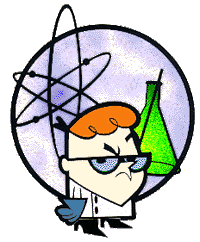
Dexter's Laboratory is from my point of view some of the best work to study for anyone wanting to learn the craft. Certainly the works of Clampett, Freleng, Jones and Avery also are meant to be studied.
A great place to start a discussion of the importance of characters in writing for cartoons is with John Kricfalusi’s characters Ren and Stimpy. I have to confess that I’m a big fan of Kricfalusi’s work. Ren Hoek and Stimpson J. Cat are surely two of the most inventive cartoon characters to come along. And they are certainly worth spending some time and study to understand.
There of course is the basic background behind the characters. Stimpy is a classical simple minded character with an interesting twist. Kricfalusi didn’t want to follow the mold exactly, he wanted to capture the Looney Tunes and Tex Avery style slow witted childlike type of character but not the traditional “Which way did he go George” style of stereotyped voice, so he chose to give Stimpy a parody voice of Larry Fine from the Three Stooges. When you study Kricfalusi’s work you will find that this type of creative choice is very consistent as he is a strong believer in the importance of contrasts. Stimpy is a simple child but he talks with the voice of a grown man. I particularly like the way Kricfalusi characterizes Stimpy when he describes him as someone who thinks he is smart even though he really is “several bricks shy of a full load”. Stimpy is almost totally without the ability to feel pain and he just has this giant nerve ending that responds to being hit and slapped around. If you hit him hard enough and long enough he will eventually respond with great pleasure and love you forever. Ren is also a study in contrasts. He is an Asthma Hound Chihuahua with the voice of the great character actor Peter Lorrie. Ren is very short tempered, incredibly selfish, greedy, and mean. He is cruel to Stimpy and everyone else. Ren is prone to failure, and sometimes crying fits and psychotic outbursts. He uses his friend Stimpy as a patsy who is always there for him. He collects Dinosaur Droppings and Rare Infectious Diseases, and other unusual things. Ren is often jealous of Stimpy's good luck, and usually slaps him silly.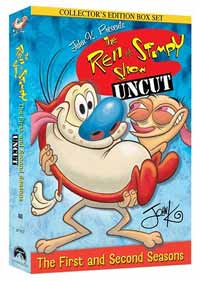
The two characters follow a great tradition of comedy teams like Abbott and Costello or Laurel and Hardy. They are in direct contrast. Ren is angular and wiry looking while Stimpy is pudgy and round. Stimpy is a kind hearted simpleton while Ren is a mean spirited scheming con man. Stimpy is so cute and lovable, but he is oh so stupid. It seems that he ran into a few too many walls when he was a kitten. He likes Muddy Mudskipper and Gritty Kitty Litter. He is roley poly, and drools a lot. He is pretty much a whipping boy for Ren. Stimpy likes to talk to the boogers that he keeps under a table, and he is a charter member of the Loyal Order of Stupids.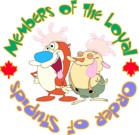
Kricfalusi is a real fan of Bob Clampett and Tex Avery so it isn't hard to see that he would pattern one of his main characters after Daffy Duck and the other after Droopy the Dog. But Ren and Stimpy are influenced by these characters and yet unique and original at the same time. The important thing to note about the Ren and Stimpy cartoons is that they are totally character driven. Each episode follows in the Warner Bros. tradition of placing well established characters into situations and just letting their personalities guide the outcome. –End of Part 2-
Getting Back To Cartoony Cartoons Part 1
This is the first in a multi-part series on the subject of cartoons and cartoon making. My goal in these articles is to explore writing and making the short format cartoon which can range in length from 1 to 7 minutes.
I come from a very biased viewpoint that the short format cartoon is meant to be both entertaining and cartoony. You might think, “Well, OK that seems obvious.” But, it isn’t obvious at least not if you take a more critical look at many of the short format cartoons of recent times. The vast majority of today’s animated cartoons are marginally entertaining and they totally have lost sight of the cartoony aspects of the medium. Let’s begin with some historical perspective.
Walt Disney and others began with cartoons in the 1920’s and 1930’s that mostly capitalized on the audience of the time's total fascination with the newly developed medium of animation. It was all based on novelty. Things like basic moving pictures, sound and then color. If you go back and watch most of those cartoons today, they don't really hold up well as entertainment. Many were not much more than moving comic strips, others were mostly funny drawings dancing around to music. You can learn a lot from the series titles of these early works, Silly Symphonies, Merry Melodies, and Looney Tunes to name a few. They were all about the magic of and fascination with moving characters and music in syncronization in the new talking pictures. Merry Melodies and Looney Tunes evolved away from that format almost to the point that most people don't remember or realize the origin of those series names. Early cartoons were very innovative technically and we all owe a great deal of gratitude to those pioneers for their contributions and vision but they weren't cartoony. 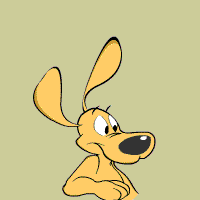
The late 1930's and 1940's saw real innovations and change in animated cartoons. Mostly lead by defectors from the Disney Studios, who craved more freedom of expression and rebelled against Walt's personal vision of animated film making. The most influential creators, in my opinion were Bob Clampett, Tex Avery, and Chuck Jones. I also think Friz Freleng and Robert McKimson are highly underrated but that's primarily due to the totally revolutionary and innovative levels of work produced by Clampett, Avery, and Jones. Clampett and Avery were much more aggressive and progressive. They were big risk takers and created very influential styles. To the extent that they pushed visual gags and exaggeration to their limits they can rightly be considered the visual masters and originators of the cartoony cartoon. Chuck Jones was much more conservative in his approach, but in the long run perhaps he is the best loved and remembered of the three. Clampett and Avery moved in leaps and bounds while Jones took lots of baby steps but ultimately produced the larger body of significant work. And as talked about in my prior article The Less Limited Expressive Possibilities of Limited Animation – Part 2, Jones created the model for the modern cartoon with his revolutionary work “The Dover Boys”.
Then came the UPA contribution to cartoon making, the hip, stylized, design oriented, limited animation works of the 1950’s. Although these cartoons were and still are considered highly influentual on today’s creators. It is also possible to point to them as the beginning of the decline in modern cartoon making. They were creative and inventive but yet they often in there attempt to achieve a level of New Yorker Magazine sophistication just plain weren’t that funny. They were more oriented to the stylized magazine humor of their time and they lost both the prior decades visual and situational cartoony edge
The next major group of really influential cartoons which I feel has great staying power and generational appeal came in the 1960's. They came from the combination of Jay Ward and Bill Scott. The Rocky and Bullwinkle series which included Fractured Fairy Tales and Dudley Do Right followed by George of the Jungle is still very funny stuff. Unlike the work of the Warner Bros and MGM studios of the prior group, Ward and Scott worked under a great handicap in terms of animation production (financially and politically they were forced to outsource their animation production to an inexperienced studio in Mexico) but they more than made up for it with great situations, inventive ideas and very funny dialogue and voice characterizations. In my opinion the Jay Ward Productions brought the cartoony back to cartoons although not the visual style of exaggeration made famous by Clampett, Avery and Jones.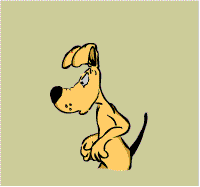
Then cartoons really entered the "dark ages" of their history for at least two decades. A period often referred to as the infomercial age of cartoons. From He-Man to Transformers to the Hanna Barbera line up on Saturday mornings it was one endless parade of mediocrity. Finally in the early 1990's a new life came back into cartoons. I think the most durable creation will be the Simpsons. I also like South Park but don't think it will be as long remembered. I think the most influential and greatest talents in recent animation are John Kricfalusi and Genndy Tartakovsky. Kricfalusi, much like his role model Bob Clampett, seems doomed to be his own worst enemy. He's brilliant, talented beyond imagination and totally able to "piss off" everyone in a position to help him get his work seen. But even though his own personal work will probably be more limited than it should be due to his personality and temperament, John Kricfalusi has in the last 10 plus years directly and indirectly influenced an entire generation of cartoon making talent. I predict that in twenty or thirty years, John Kricfaluci's work will be pointed to as timelessly great cartoons. Unfortunately his work won't be very well known because of its relatively small production volume. (Number of toons actually made). Genndy Tartakovsky continues to create new and highly innovative work and hopefully will return to his more humorous roots over time. Still with just a few exceptions today’s cartoons aren’t as clever in situation or humor or as visually exaggerated as their processors. They aren’t cartoony and in many cases they aren’t that entertaining. As cartoon makers we need to better understand what makes cartoons cartoony and set our sights to regain that former glory.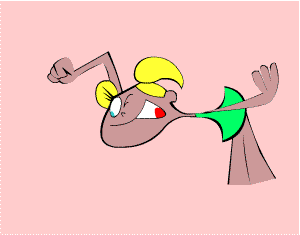
It doesn't matter how smooth the drawings or renderings. It doesn't matter what animation medium you choose, 2D, 3D CGI, claymation. It doesn't matter what your distribution medium, TV, Movie Theater, DVD, the Internet. Ultimately what you have to say trumps how you say it.The biggest limitation of short cartoons is time, so plot based stories should be avoided. And in general plot and character development are luxuries normally only afforded to continuing animated series. There the individual duration of the cartoon episodes is less limiting. But just because plot and character development can't occupy much time in a single cartoon episode, that doesn't mean that there is no need for good writing. To the contrary, good writing is critical. Writing is very much an art and not a science so there are no absolutes, everything is ultimately opinion at best.
So what are the elements that make for good cartoon writing? My experience points to the following elements: characterization, clever dialog, funny gags, interesting situations, and inventive ideas.
Characterization is really about creating well rounded and believable characters. These are characters which are multi-dimensional and who interact with and respond to other characters and situations in a manner consistent with their unique personalities. How the character acts and reacts and what they say and how they say it all contribute to developing a believable and well rounded character. The character has to do more than funny things and deliver more than just funny lines. They have to be funny naturally. By naturally we mean that everything they do must seem appropriate and natural for whom they are. If a character seems forced, or even worse, manipulated just for the sake of advancing the story or a gag then they will not be well written. Every character is a unique personality.
Natural actions and dialog are critical to good characterization, but dialog has to be more than just natural. (By natural I mean that the dialog naturally fits the unique personality of the character speaking) Dialog should follow distinct speech patterns and never sound forced, and it should be funny and "cartoony". Cartoony means the dialog is exaggerated, contrasty and almost poetic. Dialog should at its best be so funny and compelling and memorable that it makes people want to repeat it to others. It is totally natural for StrongBad to use a phrase like "crazy go nuts". It fits his personality and every HomeStarRunner viewer quickly picks up the phrase and passes it along. Cartoon dialog like comedy dialog has rhythm and timing, as does cartoon music and animation.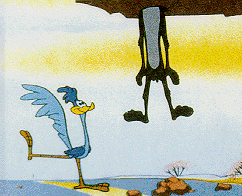
Before we begin exploring gags and how they are constructed, let's look at some of the classical situations that have successfully been used in developing many cartoons. Perhaps the most famous and most frequently used cartoon situation is the "chase". Usually a pair of characters is thrown together in this situation, the hunter and the hunted. Many classic "chases" come to mind with Wyle Coyote and Roadrunner as perhaps the purest example. The hunted character is always a sympathetic character and the hunter is usually the butt of most of the gags. What is very interesting is the observation that the hunter is usually also a sympathetic character. We care about them too, but we also love to watch them relentlessly try and fail in an ever escalating series of attempts to catch their desired pray. We love to see them fall to the bottom of that Grand Canyon in a puff of dust. We love seeing their inevitable recognition of gravity as they find themselves running in thin air. We love the bomb blowing up in their face and the boulder landing on them or the rocket strapped to their back pulling them headlong into a cliff wall. But we also really care about them and are secretly hoping they will succeed a little and we never really want them to be actually hurt because we just love the chase and the gags.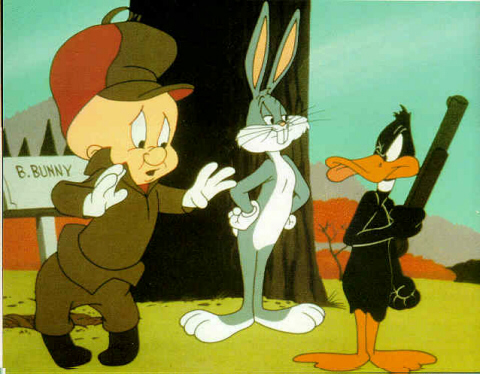
A variation of this "chase" situation is the "competition". My favorite example is Duck Season Wrabbit Season. In this type of situation we see two characters in a head to head competition where the gags sprout from their efforts. There are plenty more examples of this type of situation.
The next classic situation is the "lesson". One character for whatever reason is placed into the position of needing to instruct another character. The gags are usually focused on the teacher as everything they try to explain or demonstrate backfires. My favorite example of the lesson situation is the Foghorn Leghorn Little Chicken Hawk cartoons. Foghorn and the farm dog are bitter rivals while the Chicken Hawk is a clueless hunter. Foghorn takes the Hawk under his wing and nothing ever works as planned. Another great example of this cartoon situation was the series of Sylvester trying to teach his nephew to be a good mouser but he keeps running into the world’s largest and toughest mouse, actually a boxing kangaroo.
Another often used situation in cartoons is the "scheme" or the con job. One character sets out to pull off a scam with another character as the hapless dupe. Of course the con artist always seems to get the worst end of each transaction. Then there are the stereotypical "environment" situations. These are locations where one or more character is placed so the gags can flow. Example of these "environments" are the cemetery at midnight, a haunted house, a western saloon, a mad scientists laboratory, a rocket ship flying to mars. You have lots of preconditioned knowledge of these locations and stories centered on them so it is easy to construct gags making fun of the expected.
Yet another cartoon situation to consider is a variation on the "environment". It is the "parody". These situations take a familiar story and places one or more characters into that story in place of the original characters. There are tons of great "parody" examples; some are Robin Hood, Dragnet, Buck Rogers, and any one of a million fairy tales. Jay Ward made some of the funniest cartoons ever in his Fractured Fairy Tales segments on the Rocky and Bullwinkle shows. Just like the stereotypical "environment" these cartoons use your prior knowledge of the original story and characters as the source of their gags.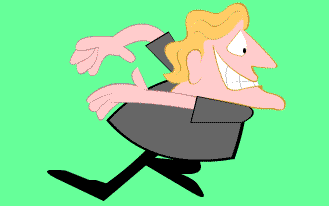
Inventive ideas are an important element in creating good cartoon writing. "Wow, that's like saying that overcoming gravity is important in flying an airplane". To a large degree how inventive we are in our creations is the essence of how well they are received. You can only drop large objects on to a character's head so many times before it stops being entertaining. Although the frog in the blender on the Internet was popular for quite some time, it certainly was never my cup of tea, no pun intended, but it was very inventive.
Certainly the choice of topics and characters is a major place to look for examples of inventive ideas. It was very inventive to take a sponge and turn it/him into a cartoon. It was very inventive to create a cartoon about a samurai warrior. And then even more inventive to take him totally out of his traditional environment and throw him into the future. Jay Ward was very inventive when he created the cartoon chapter play as a format first with Crusader Rabbit and later with Rocky and Bullwinkle. Ward also brought great inventiveness to cartoons with his "Fractured Fairy Tales", with "Aesop and Son", and with Sherman and Peabody's time travels in history. Another very inventive idea which Ward Productions really perfected was making the off camera announcer a straight man for setting up many gags. In fact the Ward folks actually made the announcer into an active character who became a part of the cartoon and even had conversations with the on screen cartoon characters.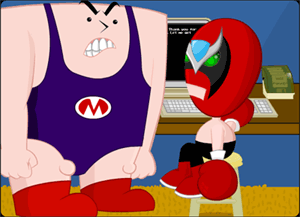
But I want to explore some examples at a less significant level in the creative process but that are certainly important in writing good cartoons. One of my favorite examples of a very inventive idea is Strong Bad's e-mails. What could be more natural than a web cartoon character sitting around answering viewers e-mails? And who could be better at doing that than a wise cracking guy like Strong Bad? There have been more than a hundred cartoons generated around this inventive idea and they are as fresh and funny now as ever.
Steve Whitehouse, one of my favorite web cartoon makers, very inventively uses sound effects and pantomime in his Mr. Man cartoons instead of dialog. If you have never watched Steve's Mr. Man Show where he produced 40 episodes about Mr. Man and Trio, the three wheeled dog, on vacation, then you have missed viewing a very well written, funny, and inventive example of the potential of web based animation. There are plenty of characters with a dog for a sidekick, but having the dog have no legs and instead having him squeak about on three wheels is just plain brilliant.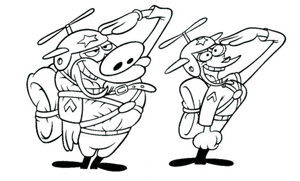
One of my favorite scenes in a cartoon is from a Ren and Stimpy episode Space Madness. The scene pans into a futuristic looking laboratory with Ren and Stimpy standing near a monolithic platform with a single red button in the center. Ren begins in characteristic frenzied dialogue to layout the setup for this gag. He tells Stimpy that it is his, Stimpy's, responsibility to guard the button and in no uncertain terms he must not press the button. The camera zooms in to reveal that this red button if pressed will "erase all history". Ren strongly reinforces the warning "Don't Press the Red Button"!!!! (We know what’s coming.) Ren leaves Stimpy alone on guard duty. The background music is straight out of a 1936 Flash Gordon serial. Stimpy is resolute in his duty. (But we know what's coming.) A narrator's "voice-over" begins in the background to build the anticipation and tension. The camera pulls back to reveal the narrator is actually standing there behind Stimpy, he's not just an off screen presence. We visually see Stimpy's internal turmoil as the urge to press the button wells up inside him. The torture to his very being is expressed in Kricfalusi's cartoony animation style. The narrator is steadily taunting Stimpy and literally climbs up on Stimpy's back and is bouncing his "butt" on to Stimpy forcing him closer and closer to pushing the red button. (We know what's coming, we have known all along, but by now we are rolling on the floor laughing.) Finally Stimpy can stand the pressure no more and presses the button. Ren rushes back into the scene as the three characters (Ren, Stimpy and the Narrator) all react in cartoony horror and anticipation of the pending disaster. The gag finishes when all three characters vanish in three black puffs of smoke. This is a really well structured gag. It begins with a strong set up, the warning. The audience is alerted and their expectations are established. Then the tension and anticipation is allowed to build. Great cartoony drawings and the inventive use of the narrator just layer on the absurdity of the situation. By the time we reach the gag's pay off, what was totally expected and predictable has evolved in a totally unexpected and unpredictable way. This sequence is perhaps one of the best combinations of the situational and visually cartoony elements of cartoon making. – End of Part 1 -
The Less Limited Expressive Possibilities of Limited Animation - Part 2
The Second World War in Europe resulted in many artists leaving for the safety of the United States, and their arrival in North America greatly extended their artistic influence. It is impossible to estimate how much they affected American art, but the fact remains that in the 1940s and '50s, the artistic community in American developed a new vision and new artistic vocabulary, known as Abstract Expressionism.
Abstract Expressionism does not describe any one particular style, but rather a general attitude, an outlook characterized by a spirit of innovation and a belief in freedom of expression. So it isn’t difficult to understand how this attitude would be embraced by many in the animation industry who were feeling stifled by the working conditions and the often singular perspective of the Disney world.
To a large degree, Disney’s visions of realism in animation were a blessing and a curse. They certainly had helped to elevate the public perception of animation and to prove that animated films could be more than supporting fillers between feature motion pictures, and the codification of the fundamentals of animation was certainly a benefit as well. But at the same time the labor intensive demands of this style were choking the life out of the cartoon short. Even Disney himself was unable to continue to justify the 7 minute format.
In 1942 prior to the UPA revolution in animation, a landmark cartoon was made by Chuck Jones at Warner Bros called “The Dover Boys” and employed the use of "smear" action where characters go from one pose to another with only a few frames of animation between each position. Many historians believe that “The Dover Boys” was responsible for inspiring John Hubley and the other artists who went on to found UPA years later. How much it directly influenced them is difficult to measure, but it definitely did nothing less than create the modern cartoon.
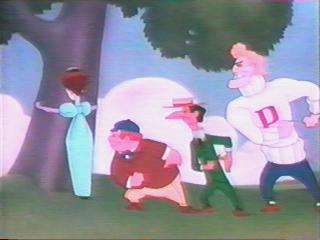 Jones initially conceived “The Dover Boys” as an exercise in stylized movement, and created a codex of cartoon shortcuts that would rule Warner Brothers Animation for the next twenty years. The prior standard for movement developed by Disney mirrored normal life. Characters moved across a room in a slow naturalistic style but in “The Dover Boys” the characters are on rocket fuel; the distance from point to point is covered in a blur of a few frames' length, and the character comes to a complete, dead stop to hit the next joke. And the gags are flying by at a breakneck pace. Jones burlesqued the stiffness of nineteenth-century photographs by throwing his characters into ludicrously theatrical poses—bulging arms folded ostentatiously across a manly chest here, maidenly arms raised in demure horror there—and calling attention to those poses by holding them on the screen for much longer than normal. The characters often shoot from one pose to another with only a few frames of film in between. The drawings in those few frames are stretched and even smeared. Disney was focused on bringing respectability to animation while Jones was aiming for freedom of expression.
Jones initially conceived “The Dover Boys” as an exercise in stylized movement, and created a codex of cartoon shortcuts that would rule Warner Brothers Animation for the next twenty years. The prior standard for movement developed by Disney mirrored normal life. Characters moved across a room in a slow naturalistic style but in “The Dover Boys” the characters are on rocket fuel; the distance from point to point is covered in a blur of a few frames' length, and the character comes to a complete, dead stop to hit the next joke. And the gags are flying by at a breakneck pace. Jones burlesqued the stiffness of nineteenth-century photographs by throwing his characters into ludicrously theatrical poses—bulging arms folded ostentatiously across a manly chest here, maidenly arms raised in demure horror there—and calling attention to those poses by holding them on the screen for much longer than normal. The characters often shoot from one pose to another with only a few frames of film in between. The drawings in those few frames are stretched and even smeared. Disney was focused on bringing respectability to animation while Jones was aiming for freedom of expression.
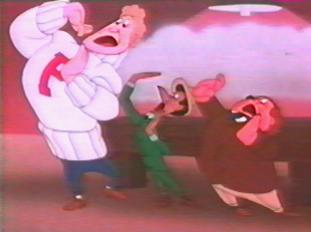 The background designs for “The Dover Boys” are likewise stylized—unusually simplified for the Schlesinger cartoons, but softened and rounded by airbrush. “The Dover Boys” pulled together successfully elements that were foreign to most of the short cartoons of the early ‘40s: human characters, parody, stylized movement and design. The cartoon was quickly recognized as something out of the ordinary. John Hubley—later a major force at UPA—spoke approvingly in 1942 of how Jones had adapted new animation techniques and new background treatment to a story material that deals with a parody on human behavior, as opposed to the "pure comedy" of the Disney cartoons.
The background designs for “The Dover Boys” are likewise stylized—unusually simplified for the Schlesinger cartoons, but softened and rounded by airbrush. “The Dover Boys” pulled together successfully elements that were foreign to most of the short cartoons of the early ‘40s: human characters, parody, stylized movement and design. The cartoon was quickly recognized as something out of the ordinary. John Hubley—later a major force at UPA—spoke approvingly in 1942 of how Jones had adapted new animation techniques and new background treatment to a story material that deals with a parody on human behavior, as opposed to the "pure comedy" of the Disney cartoons.
Hubley is quoted in a 1942 article in “The Animator” magazine as saying "A progressive, intelligent approach to animation, and realization that it is an expressive medium, is imperative if we want to keep animated cartoons from stagnating. Development and growth of animation is dependent upon varied, significant subject manner presented in an organized form, evolved from elements inherent in the medium. Among the least understood of these elements are the graphic ones.” The animation revolution had truly begun.
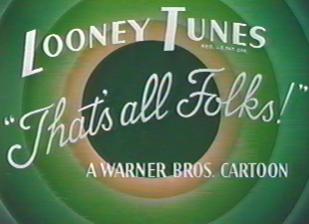 Hubley was not the only artist seeking the future and truth in the animated film at this time. Zack Schwartz, Dave Hilberman and Steve Bostustow founded a studio based on the 'ideal future' of animation. On May 1, 1944, the fast growing company took the name: United Film Production; later it became UPA. This was also the year that John Hubley became a part of the process. The lack of visual details, two dimensional characters, patterned backgrounds, and overlapping color and lines became the UPA trademark look. Inspired by Jones, the animation world became multidimensional in its thinking. Disney made animation a respected filmmaking art, and Chuck Jones opened the doors to freedom of artistic expression.
Hubley was not the only artist seeking the future and truth in the animated film at this time. Zack Schwartz, Dave Hilberman and Steve Bostustow founded a studio based on the 'ideal future' of animation. On May 1, 1944, the fast growing company took the name: United Film Production; later it became UPA. This was also the year that John Hubley became a part of the process. The lack of visual details, two dimensional characters, patterned backgrounds, and overlapping color and lines became the UPA trademark look. Inspired by Jones, the animation world became multidimensional in its thinking. Disney made animation a respected filmmaking art, and Chuck Jones opened the doors to freedom of artistic expression.
If you step back from the disdain that has been heaped on stylized limited animation and view it as one more choice in an endless spectrum of creative possibilities, you can begin to appreciate that there is still significant room for creative and entertaining expression outside the world of fluid realism.
The Less Limited Expressive Possibilities of Limited Animation – Part 1
In the 1950’s and 1960’s, what has been labeled as “limited” animation, a logical evolution in technique, signified a major transformation in the established aesthetics of the art form. During the animation industry developmental years of 1930’s and 1940’s, the pioneers at the Disney Studios evolved a highly naturalistic aesthetic, striving to make their drawings look as real as possible within the limitations of hand drawn art. The feature film Snow White is perhaps one of the best examples of how the Disney artists established their vision for the future of animation. Then, inspired by late 1940’s art movements such as abstract expressionism which rejected this naturalistic approach, avant-garde principles began to filter down into cartoons. In particular, United Productions of America (UPA), a studio that employed many animators who had left Disney during the 1941 animation industry labor strike, championed an aesthetic that emphasized abstract line, shape, and pattern over the more naturalistic style. In many respects they were expressing a logical desire to differentiate their art form of animation from the more general art form of cinema.
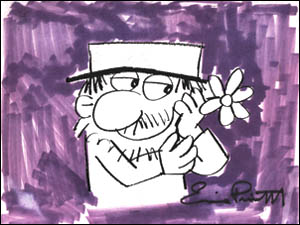
Flebus by Ernie Pintoff.
The UPA style was characterized by flattened perspective, abstract backgrounds, strong primary colors, and what has become labeled as "limited" animation. Instead of using perspective to create the illusion of depth in their drawings, the UPA style cartoons looked flat, like blobs of shape and color. Instead of naturalistic highly detailed backgrounds, these new cartoons presented backgrounds that contained strokes of color, with small squiggles that were just abstract representations of real objects. Instead of varying the shades and hues to imply the colors of the natural world, UPA's cartoons contained bold, bright, saturated colors that popped. Just as in the world of painting where realism had been replaced by impressionist abstraction, so had an evolution of style come to animation.
Most importantly for the future development of cartooning, UPA used animation that was “limited” in three ways. First, the amount of movement within each frame was substantially reduced. Rather than have a cartoon character move their entire body in a shot, they would only move a single body part like their mouth or their eyes while most of the drawings where held unchanged. Second, in limited animation, character movements are often repeated which is referred to as a cycle. A character action, for instance, might contain only a few distinct movements which are then repeated without change. Full animation, in contrast, includes many unique movements and avoids any hint of repetition. Third, limited animation uses fewer individual drawings to represent a movement. In a more traditional style cartoon, Bugs Bunny interacting with Daffy Duck might gesture expressively in an action that when fully animated might use hundreds of discrete drawings to create that movement. Limited animation, in contrast, would create a more abbreviated representation of that gesturing by using a small fraction of that number of drawings. The result is obviously less fluid but can be equally expressive.
The UPA style of changes in animation was aesthetically inspired, but it also could be viewed as good economic sense. Flattened perspective, abstract backgrounds, strong primary colors, and limited animation resulted in cartoons that were easier, quicker and cheaper to make. The 1950’s and 1960’s saw financial pressures on the animation industry that caused other studios to quickly adopt these economical practices, but their new interpretations abandoned many of UPA's abstract expressionism inspired aesthetics. Much of the reason for this shift can be attributed to the disdain that many animation creators had for the tightened production costs that were being imposed. Faster, easier and cheaper in an already under paid and under appreciated art form created significant resentment and much of what followed in the 1960’s to the 1980’s reflects a “just going through the motions to make a pay check” perspective of watered down art. It is interesting how the attitudes of the times get reflected in the quality of the work produced and how all of that disdain translated to a style of animation production which in its origin was meant to be a more expressive evolution of the art form.
In Part 2, I will begin to strip away the layers of disdain and see if we can rediscover the more expressive nature of this style.





















 Jones initially conceived “The Dover Boys” as an exercise in stylized movement, and created a codex of cartoon shortcuts that would rule Warner Brothers Animation for the next twenty years. The prior standard for movement developed by Disney mirrored normal life. Characters moved across a room in a slow naturalistic style but in “The Dover Boys” the characters are on rocket fuel; the distance from point to point is covered in a blur of a few frames' length, and the character comes to a complete, dead stop to hit the next joke. And the gags are flying by at a breakneck pace. Jones burlesqued the stiffness of nineteenth-century photographs by throwing his characters into ludicrously theatrical poses—bulging arms folded ostentatiously across a manly chest here, maidenly arms raised in demure horror there—and calling attention to those poses by holding them on the screen for much longer than normal. The characters often shoot from one pose to another with only a few frames of film in between. The drawings in those few frames are stretched and even smeared. Disney was focused on bringing respectability to animation while Jones was aiming for freedom of expression.
Jones initially conceived “The Dover Boys” as an exercise in stylized movement, and created a codex of cartoon shortcuts that would rule Warner Brothers Animation for the next twenty years. The prior standard for movement developed by Disney mirrored normal life. Characters moved across a room in a slow naturalistic style but in “The Dover Boys” the characters are on rocket fuel; the distance from point to point is covered in a blur of a few frames' length, and the character comes to a complete, dead stop to hit the next joke. And the gags are flying by at a breakneck pace. Jones burlesqued the stiffness of nineteenth-century photographs by throwing his characters into ludicrously theatrical poses—bulging arms folded ostentatiously across a manly chest here, maidenly arms raised in demure horror there—and calling attention to those poses by holding them on the screen for much longer than normal. The characters often shoot from one pose to another with only a few frames of film in between. The drawings in those few frames are stretched and even smeared. Disney was focused on bringing respectability to animation while Jones was aiming for freedom of expression. The background designs for “The Dover Boys” are likewise stylized—unusually simplified for the Schlesinger cartoons, but softened and rounded by airbrush. “The Dover Boys” pulled together successfully elements that were foreign to most of the short cartoons of the early ‘40s: human characters, parody, stylized movement and design. The cartoon was quickly recognized as something out of the ordinary. John Hubley—later a major force at UPA—spoke approvingly in 1942 of how Jones had adapted new animation techniques and new background treatment to a story material that deals with a parody on human behavior, as opposed to the "pure comedy" of the Disney cartoons.
The background designs for “The Dover Boys” are likewise stylized—unusually simplified for the Schlesinger cartoons, but softened and rounded by airbrush. “The Dover Boys” pulled together successfully elements that were foreign to most of the short cartoons of the early ‘40s: human characters, parody, stylized movement and design. The cartoon was quickly recognized as something out of the ordinary. John Hubley—later a major force at UPA—spoke approvingly in 1942 of how Jones had adapted new animation techniques and new background treatment to a story material that deals with a parody on human behavior, as opposed to the "pure comedy" of the Disney cartoons. Hubley was not the only artist seeking the future and truth in the animated film at this time. Zack Schwartz, Dave Hilberman and Steve Bostustow founded a studio based on the 'ideal future' of animation. On May 1, 1944, the fast growing company took the name: United Film Production; later it became UPA. This was also the year that John Hubley became a part of the process. The lack of visual details, two dimensional characters, patterned backgrounds, and overlapping color and lines became the UPA trademark look. Inspired by Jones, the animation world became multidimensional in its thinking. Disney made animation a respected filmmaking art, and Chuck Jones opened the doors to freedom of artistic expression.
Hubley was not the only artist seeking the future and truth in the animated film at this time. Zack Schwartz, Dave Hilberman and Steve Bostustow founded a studio based on the 'ideal future' of animation. On May 1, 1944, the fast growing company took the name: United Film Production; later it became UPA. This was also the year that John Hubley became a part of the process. The lack of visual details, two dimensional characters, patterned backgrounds, and overlapping color and lines became the UPA trademark look. Inspired by Jones, the animation world became multidimensional in its thinking. Disney made animation a respected filmmaking art, and Chuck Jones opened the doors to freedom of artistic expression.
